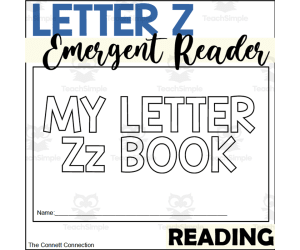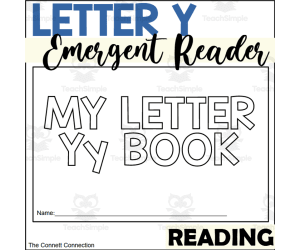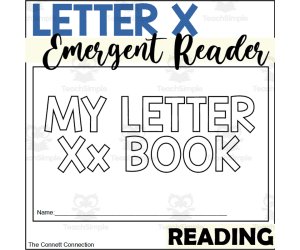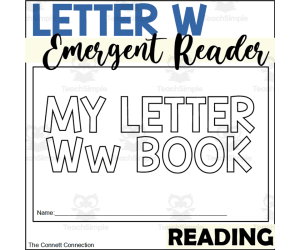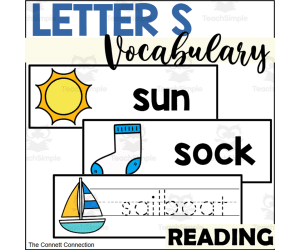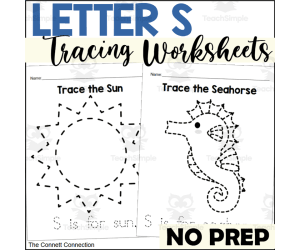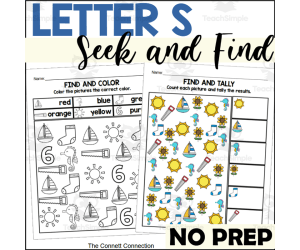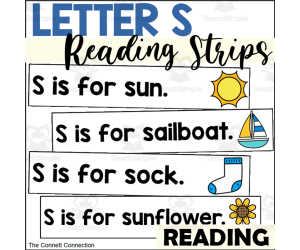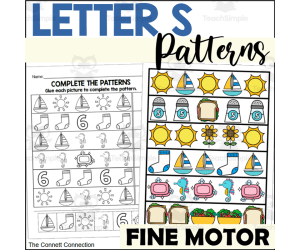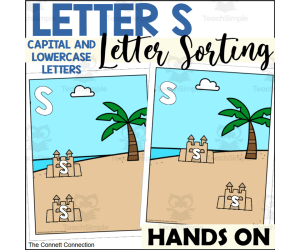2,775 products added recently
Page 647 - Newest Teaching Resources
Letter V Games
ELA, Language Development, Phonics, Kindergarten, Preschool, Activities, Games
This letter V beginning sound game is an interactive way for students to work on words that begin with the letter V. This alphabet game provides students with a fun and engaging way to practice on the initial sound of the letter V. This game focuses on the most common sound of the initial /v/ sound. What is Included: One gameboard in color One gameboard in black and white What do you need to play: One of the gameboards A die Something to mark the inner spaces with A player piece to move around the edge of the board This game can be a single player game or a two player game. To play, each student will need one gameboard, one die, 20 objects to mark the inner part of the game board, and a game piece for each student playing. First, a student will roll the die and move his game piece around the outside of the gameboard. The student will then cover the corresponding picture in the middle of the gameboard. The winner or end of game can be determined by one of the following rules below, depending on if the student is playing alone or with a partner. This can be a single player game using the following rules: The player tries to get 4 pictures covered in a row to win The player tries to cover all the spaces in a set time limit This can be a two player game by using the following rules: Who can cover the most spaces in a specific time limit Who can cover half (10 spaces) of the board first When to Use: Literacy Center Small Group Activity Morning Tubs or Baskets Individual Activity Early Finisher Game File Folder Game Partner Activity Skills Assessed: Beginning Sound of the Letter V Counting Following Directions
Author The Connett Connection
Tags Alphabet Activities, Alphabet Games, Beginning Sounds, Initial Sounds, Letter Of The Week, Phonics Game, Alphabet Center, Letter V, Letter V Activities, Letter V Games
Letter U Games
ELA, Language Development, Phonics, Kindergarten, Preschool, Activities, Games
This letter U beginning sound game is an interactive way for students to work on words that begin with the letter U. This alphabet game provides students with a fun and engaging way to practice on the initial sound of the letter U. This game focuses on the most common sound of the initial /u/ sound. What is Included: One gameboard in color One gameboard in black and white What do you need to play: One of the gameboards A die Something to mark the inner spaces with A player piece to move around the edge of the board This game can be a single player game or a two player game. To play, each student will need one gameboard, one die, 20 objects to mark the inner part of the game board, and a game piece for each student playing. First, a student will roll the die and move his game piece around the outside of the gameboard. The student will then cover the corresponding picture in the middle of the gameboard. The winner or end of game can be determined by one of the following rules below, depending on if the student is playing alone or with a partner. This can be a single player game using the following rules: The player tries to get 4 pictures covered in a row to win The player tries to cover all the spaces in a set time limit This can be a two player game by using the following rules: Who can cover the most spaces in a specific time limit Who can cover half (10 spaces) of the board first When to Use: Literacy Center Small Group Activity Morning Tubs or Baskets Individual Activity Early Finisher Game File Folder Game Partner Activity Skills Assessed: Beginning Sound of the Letter U Counting Following Directions
Author The Connett Connection
Tags Alphabet Activities, Alphabet Games, Beginning Sounds, Initial Sounds, Letter Of The Week, Phonics Game, Alphabet Center, Letter U, Letter U Games, Letter U Activities
Letter T Games
ELA, Language Development, Phonics, Kindergarten, Preschool, Activities, Games
This letter T beginning sound game is an interactive way for students to work on words that begin with the letter T. This alphabet game provides students with a fun and engaging way to practice on the initial sound of the letter T. This game focuses on the most common sound of the initial /t/ sound. What is Included: One gameboard in color One gameboard in black and white What do you need to play: One of the gameboards A die Something to mark the inner spaces with A player piece to move around the edge of the board This game can be a single player game or a two player game. To play, each student will need one gameboard, one die, 20 objects to mark the inner part of the game board, and a game piece for each student playing. First, a student will roll the die and move his game piece around the outside of the gameboard. The student will then cover the corresponding picture in the middle of the gameboard. The winner or end of game can be determined by one of the following rules below, depending on if the student is playing alone or with a partner. This can be a single player game using the following rules: The player tries to get 4 pictures covered in a row to win The player tries to cover all the spaces in a set time limit This can be a two player game by using the following rules: Who can cover the most spaces in a specific time limit Who can cover half (10 spaces) of the board first When to Use: Literacy Center Small Group Activity Morning Tubs or Baskets Individual Activity Early Finisher Game File Folder Game Partner Activity Skills Assessed: Beginning Sound of the Letter T Counting Following Directions
Author The Connett Connection
Tags Alphabet Activities, Alphabet Games, Beginning Sounds, Initial Sounds, Letter Of The Week, Phonics Game, Alphabet Center, Letter T, Letter T Games, Letter T Activities
Letter Z Emergent Reader
ELA, Language Development, Phonics, Reading, Kindergarten, Preschool, Activities
This letter Z emergent reader is a great book for practicing beginning sounds. This book is a low prep activity for students to make and take home to practice the initial sound of the letter Z. These beginning readers are perfect for any preschool or kindergarten classroom where students are learning about the letter Z and its most common initial sound. This emergent reader includes a cover page and seven different "Z is for..." pages that all focus on the most common sound of the letter Z in the initial position of the word. What is Included: Letter Z emergent reader cover page. Z is for zebra. Z is for zero. Z is for zoo. Z is for zucchini. Z is for zeppelin. Z is for zip. Z is for zinnia. Students can be guided to color each picture first and then cut the pages apart. There are two emergent reader pages for each printed page. The pages will then be stapled together in a book for students to read over and over to practice the letter Z sound. All pictures in this book focus on the initial /z/ sound. The pages can be stapled together in any order as long as the cover page is on top. When to Use: Literacy Center Reading Center Small Group Activity Independent Activity Emergency Sub Plans Use as mini books in a class library These alphabet emergent readers make great student made books for them to take home and read with their families or for placing in a class library for students to read again and again during center time. Teachers can laminate the book pages for durability if using within a reading center . Skills Assessed: Letter Recognition Initial Sound of the Letter Z Reading simple sight words Reading simple repetitive sentences For similar resources, visit my store!
Author The Connett Connection
Tags Emergent Reader, Beginning Sounds, Beginning Reader, Alphabet Reader, Alphabet Book, Alphabet Activity, Letter Of The Week, Letter Z, Letter Z Book, Letter Z Activities
Letter Y Emergent Reader
ELA, Language Development, Phonics, Reading, Kindergarten, Preschool, Activities
This letter Y emergent reader is a great book for practicing beginning sounds. This book is a low prep activity for students to make and take home to practice the initial sound of the letter Y. These beginning readers are perfect for any preschool or kindergarten classroom where students are learning about the letter Y and its most common initial sound. This emergent reader includes a cover page and seven different "Y is for..." pages that all focus on the most common sound of the letter Y in the initial position of the word. What is Included: Letter Y emergent reader cover page. Y is for yarn. Y is for yo-yo. Y is for yolk. Y is for yogurt. Y is for yam. Y is for yak. Y is for yacht. Students can be guided to color each picture first and then cut the pages apart. There are two emergent reader pages for each printed page. The pages will then be stapled together in a book for students to read over and over to practice the letter Y sound. All pictures in this book focus on the initial /y/ sound. The pages can be stapled together in any order as long as the cover page is on top. When to Use: Literacy Center Reading Center Small Group Activity Independent Activity Emergency Sub Plans Use as mini books in a class library These alphabet emergent readers make great student made books for them to take home and read with their families or for placing in a class library for students to read again and again during center time. Teachers can laminate the book pages for durability if using within a reading center . Skills Assessed: Letter Recognition Initial Sound of the Letter Y Reading simple sight words Reading simple repetitive sentences For similar resources, visit my store!
Author The Connett Connection
Tags Emergent Reader, Beginning Sounds, Beginning Reader, Alphabet Reader, Alphabet Book, Alphabet Activity, Letter Of The Week, Letter Y, Letter Y Book, Letter Y Activities
Letter X Emergent Reader
ELA, Language Development, Phonics, Reading, Kindergarten, Preschool, Activities
This letter X emergent reader is a great book for practicing letter sounds. This book is a low prep activity for students to make and take home to practice the most common letter sound of the letter X. These letter sound readers are perfect for any preschool or kindergarten classroom where students are learning about the letter X and its most common sound. This emergent reader includes a cover page and seven different "X is for..." pages that all focus on the most common sound of the letter X. What is Included: Letter X emergent reader cover page. X is for fix. X is for wax. X is for six. X is for fox. X is for mix. X is for ax. X is for box. Students can be guided to color each picture first and then cut the pages apart. There are two emergent reader pages for each printed page. The pages will then be stapled together in a book for students to read over and over to practice the letter X sound. All pictures in this book focus on the final /x/ sound. The pages can be stapled together in any order as long as the cover page is on top. When to Use: Literacy Center Reading Center Small Group Activity Independent Activity Emergency Sub Plans Use as mini books in a class library These alphabet emergent readers make great student made books for them to take home and read with their families or for placing in a class library for students to read again and again during center time. Teachers can laminate the book pages for durability if using within a reading center . Skills Assessed: Letter Recognition Letter Sound of the Letter X Reading simple sight words Reading simple repetitive sentences For similar resources, visit my store!
Author The Connett Connection
Tags Emergent Reader, Beginning Sounds, Beginning Reader, Alphabet Reader, Alphabet Book, Alphabet Activity, Letter Of The Week, Letter X, Letter X Book, Letter X Activity
Letter W Emergent Reader
ELA, Language Development, Phonics, Reading, Kindergarten, Preschool, Activities
This letter W emergent reader is a great book for practicing beginning sounds. This book is a low prep activity for students to make and take home to practice the initial sound of the letter W. These beginning readers are perfect for any preschool or kindergarten classroom where students are learning about the letter W and its most common initial sound. This emergent reader includes a cover page and seven different "W is for..." pages that all focus on the most common sound of the letter W in the initial position of the word. What is Included: Letter W emergent reader cover page. W is for worm. W is for windmill. W is for waffle. W is for watermelon. W is for web. W is for wand. W is for wagon. Students can be guided to color each picture first and then cut the pages apart. There are two emergent reader pages for each printed page. The pages will then be stapled together in a book for students to read over and over to practice the letter W sound. All pictures in this book focus on the initial /w/ sound. The pages can be stapled together in any order as long as the cover page is on top. When to Use: Literacy Center Reading Center Small Group Activity Independent Activity Emergency Sub Plans Use as mini books in a class library These alphabet emergent readers make great student made books for them to take home and read with their families or for placing in a class library for students to read again and again during center time. Teachers can laminate the book pages for durability if using within a reading center . Skills Assessed: Letter Recognition Initial Sound of the Letter W Reading simple sight words Reading simple repetitive sentences For similar resources, visit my store!
Author The Connett Connection
Tags Emergent Reader, Beginning Sounds, Beginning Reader, Alphabet Reader, Alphabet Book, Alphabet Activity, Letter Of The Week, Letter W, Letter W Books, Letter W Activities
Letter V Emergent Reader
ELA, Language Development, Phonics, Reading, Kindergarten, Preschool, Activities
This letter V emergent reader is a great book for practicing beginning sounds. This book is a low prep activity for students to make and take home to practice the initial sound of the letter V. These beginning readers are perfect for any preschool or kindergarten classroom where students are learning about the letter V and its most common initial sound. This emergent reader includes a cover page and seven different "V is for..." pages that all focus on the most common sound of the letter V in the initial position of the word. What is Included: Letter V emergent reader cover page. V is for volleyball. V is for volcano. V is for violin. V is for vest. V is for vegetables. V is for van. V is for vase. Students can be guided to color each picture first and then cut the pages apart. There are two emergent reader pages for each printed page. The pages will then be stapled together in a book for students to read over and over to practice the letter V sound. All pictures in this book focus on the initial /v/ sound. The pages can be stapled together in any order as long as the cover page is on top. When to Use: Literacy Center Reading Center Small Group Activity Independent Activity Emergency Sub Plans Use as mini books in a class library These alphabet emergent readers make great student made books for them to take home and read with their families or for placing in a class library for students to read again and again during center time. Teachers can laminate the book pages for durability if using within a reading center . Skills Assessed: Letter Recognition Initial Sound of the Letter V Reading simple sight words Reading simple repetitive sentences For similar resources, visit my store!
Author The Connett Connection
Tags Emergent Reader, Beginning Sounds, Beginning Reader, Alphabet Reader, Alphabet Book, Alphabet Activity, Letter Of The Week, Letter V, Letter V Books, Letter V Activities
Letter U Emergent Reader
ELA, Language Development, Phonics, Reading, Kindergarten, Preschool, Activities
This letter U emergent reader is a great book for practicing beginning sounds. This book is a low prep activity for students to make and take home to practice the initial sound of the letter U. These beginning readers are perfect for any preschool or kindergarten classroom where students are learning about the letter U and its most common initial sound. This emergent reader includes a cover page and seven different "U is for..." pages that all focus on the most common sound of the letter U in the initial position of the word. What is Included: Letter U emergent reader cover page. U is for umbrella. U is for unlock. U is for umpire. U is for underwear. U is for upset. U is for up. U is for under. Students can be guided to color each picture first and then cut the pages apart. There are two emergent reader pages for each printed page. The pages will then be stapled together in a book for students to read over and over to practice the letter U sound. All pictures in this book focus on the initial /u/ sound. The pages can be stapled together in any order as long as the cover page is on top. When to Use: Literacy Center Reading Center Small Group Activity Independent Activity Emergency Sub Plans Use as mini books in a class library These alphabet emergent readers make great student made books for them to take home and read with their families or for placing in a class library for students to read again and again during center time. Teachers can laminate the book pages for durability if using within a reading center . Skills Assessed: Letter Recognition Initial Sound of the Letter U Reading simple sight words Reading simple repetitive sentences For similar resources, visit my store!
Author The Connett Connection
Tags Emergent Reader, Beginning Sounds, Beginning Reader, Alphabet Reader, Alphabet Book, Alphabet Activity, Letter Of The Week, Letter U, Letter U Book, Letter U Activity
Letter T Emergent Reader
ELA, Language Development, Phonics, Reading, Kindergarten, Preschool, Activities
This letter T emergent reader is a great book for practicing beginning sounds. This book is a low prep activity for students to make and take home to practice the initial sound of the letter T. These beginning readers are perfect for any preschool or kindergarten classroom where students are learning about the letter T and its most common initial sound. This emergent reader includes a cover page and seven different "T is for..." pages that all focus on the most common sound of the letter T in the initial position of the word. What is Included: Letter T emergent reader cover page. T is for turtle. T is for tooth. T is for tornado. T is for tiger. T is for tomato. T is for tent. T is for ticket. Students can be guided to color each picture first and then cut the pages apart. There are two emergent reader pages for each printed page. The pages will then be stapled together in a book for students to read over and over to practice the letter T sound. All pictures in this book focus on the initial /t/ sound. The pages can be stapled together in any order as long as the cover page is on top. When to Use: Literacy Center Reading Center Small Group Activity Independent Activity Emergency Sub Plans Use as mini books in a class library These alphabet emergent readers make great student made books for them to take home and read with their families or for placing in a class library for students to read again and again during center time. Teachers can laminate the book pages for durability if using within a reading center . Skills Assessed: Letter Recognition Initial Sound of the Letter T Reading simple sight words Reading simple repetitive sentences For similar resources, visit my store!
Author The Connett Connection
Tags Emergent Reader, Beginning Sounds, Beginning Reader, Alphabet Reader, Alphabet Book, Alphabet Activity, Letter Of The Week, Letter T, Letter T Books, Letter T Activities
Letter G Flower Craft
ELA, Language Development, Phonics, Kindergarten, Preschool, Crafts, Activities
Enhance the teaching and learning of the beginning sound of letter G with our unique and interactive flower craftivity. This educational tool is designed to facilitate the understanding and recognition of the letter G sound with common, easy to recognize images. Our resource contains three different letter G flower templates to practice both beginning sounds as well as letter recognition. What's Included: There are two different templates that allow students to create a flower focused on recognizing the beginning sound of the letter G. There is one template that allows students to create a flower focused on letter recognition of both capital and lowercase forms of the letter G. Utilizing this Resource: Simply print the flower templates, and then allow the students to color, cut out, and assemble into a flower on colored construction paper. You can also print the flower design onto colored card stock to create a sorting activity . The flower will need to be cut and laminated. This can function as interactive materials in a literacy center, where students can match pictures to the correct letter G flower. Mix and match these with flowers of other letter flower crafts to encourage sorting and classification exercises. Possible Applications: Literacy Centers Classroom decorations or bulletin board displays Creative or Craft Sessions Individual Work Group-based Activities Supplementary Homework These flower craft templates are a perfect fit for educators seeking no-prep resources. All that is required is to print the craft page and distribute it to the students. Basic craft materials such as coloring tools, scissors, glue, and a base paper for the flower craft are needed. Each craft prints on a single page, promoting paper conservation, which aligns with an eco-friendly classroom. Skills Addressed: Identification of the beginning sound of the letter G Recognizing the capital and lowercase letter G Development of Scissors Skills Improvement of Direction Following abilities
Author The Connett Connection
Tags Flower Craft, Preschool Craft, Kindergarten Craft, Beginning Sounds, Letter Recognition, Letter G, Letter G Activities, Letter G Crafts
Letter H Dot Painting
ELA, Creative Arts, Art, Language Development, Phonics, Kindergarten, Preschool, Activities, Crafts
Title: Letter H Dot Painting Embrace an innovative approach to learning letters and boosting fine motor skills with these letter H dot painting worksheets. With this comprehensive resource, educators can engage students effectively while nurturing creativity and early literacy development. This package contains a total of 9 pages dot painting worksheets One heart dot painting page One hat dot painting page One honey dot painting page One capital letter dot painting page One lowercase letter dot painting page One dot painting page with both capital and lowercase letters Two worksheets for students to independently design their own letter H Ways to Use: Art or Literacy Center - The teacher can place these worksheets with paint and cotton swabs in the center for students to complete. Quiet Time Activity - For programs that utilize nap times, these dot painting worksheets are perfect for teachers to give to those who do not nap as an activity to complete quietly. Morning Work - These worksheets are perfect to put out as morning work for students to work on while classmates arrive to class. Sub Plans - These worksheets make great sub plans as they are easy to explain and implement in the classroom. The Skills Assessed by This Activity : Promotes letter recognition and letter sound knowledge. Fosters important skills like hand-eye coordination and stimulates creativity as they choose colors and patterns specific to their personalized artwork. Builds fine motor skills while maintaining a clean learning environment owing to its low-mess nature. The Process: The process behind these activities couldn't be easier! There’s no preparation needed on part of teachers—simply print out these pages from our PDF file type. Students will need to be provided paint of various colors and cotton swabs to complete each page. The letter H dot painting worksheets reinforce learning while nurturing imagination amongst early learners - creating joyous educational experiences right at your fingertips.
Author The Connett Connection
Tags Dot Painting, Fine Motor Skills, Creativity, Early Literacy, Q-tip Painting, Alphabet Worksheets, Letter G, Letter G Art, Letter G Worksheets, Letter G Activities
Letter S Vocabulary and Tracing Cards
ELA, Writing, Handwriting, Language Development, Phonics, Vocabulary, Kindergarten, Preschool, Activities
These vocabulary and tracing cards all students to practice reading and writing letter S words . These cards include bold, clear, easy to recognize images of objects and ideas that begin with the initial sound of the letter S that are easily recognized by students. This set contains a total of 12 unique vocabulary cards with their corresponding tracing card, making these cards perfect for a wall display or a writing center activity. What is Included: There are 12 letter S vocabulary cards There are 12 letter S tracing cards These vocabulary and tracing cards are suitable for preschoolers and kindergartners who are beginning to learn about words, letters and handwriting. The vocabulary cards provide a way for students to identify things that start with the letter S and the tracing cards provide students with a fun way to practice letter formation and writing words. When to Use Literacy Center Writing Center Wall display in writing or reading center Small Group Activity Pocket Chart Display Word Wall Cards The vocabulary cards can make a great wall display in a writing center or as part of a word wall. Students will be able to reference the cards when writing or labeling pictures. These cards can also be used as a pocket chart activity where the teacher can introduce different letter S words. Students will love the vibrant, easy to identify pictures and the big, bold words. Skills Assessed Beginning Sounds Tracing Skills Letter Formation for capital and lowercase letters Manuscript Handwriting These cards are a low prep activity for teachers to create. The teacher simply needs to print the cards and cut them out. The cards can be laminated if desired. By laminating the tracing cards, the teacher can create a write and wipe activity with dry erase markers that students can reuse over and over.
Author The Connett Connection
Tags Alphabet Activities, Handwriting Practice, Handwriting Center, Writing Center, Vocabulary Cards, Alphabet Vocabulary, Letter Of The Week, Preschool Literacy, Letter R, Letter R Activities
Letter S Tracing Worksheets
ELA, Writing, Handwriting, Language Development, Phonics, Kindergarten, Preschool, Worksheets & Printables, Worksheets
These letter S worksheets all students to practice fine motor skills to help them learn handwriting with these object tracing pages. Each page features an object that starts with S for students to trace. The students can also trace each sentence at the bottom of the page. What is Included: There is a sun tracing page. There is a seahorse tracing page. These tracing pages are suitable for preschoolers and kindergartners who need extra practice with pen control, hand eye coordination, or fine motor development. The pictures are large, with simple lines for students to trace and then color if desired. Students can also trace the simple sentence at the bottom of the page. Each sentence reads "S is for ___." When to Use Literacy Center Writing Center Fine Motor Center Morning Work Independent Practice Small Group Activity Homework Emergency Sub Plan Skills Assessed Beginning S Sounds Pen Control Fine Motor Skills Letter Formation These tracing pages are a no prep activity for teachers to give to students. The teacher simply needs to print the pages and give them to students to complete. To make these alphabet tracing worksheets more engaging, teachers can provide a variety of writing utensils with which to complete the pages. Some of these ideas are listed below. Ways to Complete Pencils or colored pencils Markers or crayons Paint with paint brushes or cotton swabs Colorful pens Chalk Finger Tracing Cover with small stickers Cover with manipulatives Dry erase markers These pages can also be laminated to create a write and wipe activity where students can use dry erase markers to complete each page and to have a long-lasting, handy resource. Students may also use small manipulatives like beads or mini erasers to place along the dotted lines to create each shape. For similar resources, visit my store!
Author The Connett Connection
Tags Tracing Worksheets, Handwriting Practice, Handwriting Worksheets, Alphabet Worksheets, Letter Of The Week, Fine Motor Skills, Writing Center, Letter S, Letter S Activities, Letter S Worksheets
Letter S Spelling Puzzles
ELA, Language Development, Phonics, Spelling, Kindergarten, Preschool, Activities
Letter S Spelling Puzzles is a hands-on literacy resource for pre-K and kindergarten students to practice spelling simple words beginning with the S sound. This set of 4 colorful picture puzzles divides each S word (saw, sand, salad, sun) into individual letter pieces for children to reassemble. With engaging images like a saw, beach sand, salad, and sunny sky, these large, bold puzzles promote letter-sound connections in a fun and engaging way through independent, small group, or whole class activities. As students rebuild the spelling puzzles, they will strengthen beginning S sound recognition, spelling ability, fine motor skills, and puzzle work. Teachers appreciate the ready-to-use format aligned to literacy standards requiring minimal prep besides printing, laminating (optional), and cutting the included puzzle page. With endless implementation ideas from literacy centers to tabletop tasks, Letter S Spelling Puzzles brings spelling practice to life for early elementary students.
Author The Connett Connection
Tags Spelling Activities, Spelling Puzzles, Alphabet Activities, Alphabet Puzzles, Letter Of The Week, Literacy Center, Preschool Literacy, Kindergarten Literacy, Letter R, Letter R Activities
Letter S Seek and Find Worksheets
Math, Early Math, Numbers, Kindergarten, Preschool, Worksheets & Printables, Worksheets
With these Letter S Seek and Find Worksheets, students will practice recognizing words that begin with the letter S while counting tally marks and identifying color words with these seek and find worksheets. Students will love being able to practice math skills and reading color words while using images they already know. What is Included: There is 1 find and tally worksheets in color There is 1 find and tally worksheet in black and white There is 1 find and color worksheet To complete the find and color worksheet, students will read the color word by each picture. They will color all the images that match the picture the color indicated in the key. To complete the count and tally worksheets, students will count all the occurrences of a given picture and then mark their counting with tally marks in the boxes provided next to the appropriate picture. All images on each worksheet begin with the letter S. When to Use Literacy Center Math Center Morning Work Emergency Sub Plans Small Group Activity Independent Activity File Folder Activity Write and Wipe Activity Skills Assessed Beginning Sounds Matching Like Pictures Reading Color Words Counting Pictures in a Random Order Making and Counting Tally Marks Fine Motor Skills These worksheets are no prep. Teachers simply need to print the pages and hand them to the students to complete. To make the find and color page more interesting, teachers may give students colored dot markers to complete the worksheet. The count and tally pages can be laminated to make a write and whip activity for students to use over and over. The count and tally pages can also be placed inside a file folder for easy set up and clean up. For similar resources for the Letter R learning and more visit my store here!
Author The Connett Connection
Tags Alphabet Activities, Seek And Find, Tally Marks, Counting Worksheets, Hide And Seek, Letter Of The Week, Alphabet Worksheets, Preschool Worksheets, Letter S, Letter S Activities
Letter S Reading Strips
ELA, Language Development, Phonics, Reading, Kindergarten, Preschool, Activities
Letter S Reading Strips is a sound recognition literacy resource for preschool and kindergarten. It contains 14 sentence strips that help students identify the letter S sound at the beginning of words using supporting picture clues. Each strip has a simple sentence in the format, "S is for camera," with a corresponding image. This phonics activity is perfect for literacy centers, small groups, task boxes, or take-home practice. Teachers can use it to introduce basic sight words and build beginning sound awareness. The black and white printable strips are extremely versatile and work well for independent, partner, or whole group activities. Students can sort, match pictures, read aloud, or make their own letter S book. With 14 context picture-supported reading strips focusing solely on words that start with /s/, this resource helps assess early reading, vocabulary, and phonics in a fun and engaging way for young learners. It's an easy prep activity that kids will love using over and over again in centers or at their desks.
Author The Connett Connection
Tags Beginning Sounds, Alphabet Activities, Letter Of The Week, Reading Center, Reading Simple Sentences, Simple Sentences, Initial Sounds, Preschool Reading Center, Letter S, Letter S Activities
Letter S Reading Rings
ELA, Language Development, Phonics, Reading, Kindergarten, Preschool, Worksheets & Printables, Flashcards
These letter S reading rings are great for students learning the beginning sound of the letter S. These reading rings give students simple sentences to introduce them to reading in the format of "S is for ____." What is Included: Letter S Reading Ring cover card Letter S reading ring cards The reading rings are available in color and in black and white These reading rings are suitable for preschool and kindergarten students who are learning the initial sound of the letter S and are ready to begin reading simple sentences. The large, bold, and easy to recognize images will lead students towards success as they take the first steps to reading independently. When to Use: Literacy Centers - These cards work well in a literacy or reading center for students to read independently or with a partner. Small Group Activity - The teacher can pull aside a small group of students who need extra practice with the target sound to use these cards. Early Finisher Task - If students finish a task early, they can grab these cards to look at and read. Take Home Book - The black and white pages can be sent home for students to make their own letter sound book. This rings are easy to create. The teacher just needs to print each page, laminate each card (if desired) and then, using a hole punch, the teacher needs to place a hold in the indicated corner of the card. The cards are then placed on a ring for students to flip through each letter S card. Skills Assessed Letter S Recognition Beginning Sounds Reading Simple Sentences These reading rings provide students with a fun and engaging way to practice reading simple sentences with words that begin with the letter S. In this set, you can create a set for classroom use and the students can use the black and white set to make a set to take home and read with their families.
Author The Connett Connection
Tags Beginning Sounds, Alphabet Activities, Reading Center, Reading Activities, Emergent Readers, Beginning Readers, Preschool Readers, Flash Cards, Letter S, Letter S Activities
Letter S Puzzles
ELA, Writing, Handwriting, Kindergarten, Preschool, Worksheets & Printables, Worksheets
Letter S Puzzles These printable letter S puzzles allow young students to practice letter recognition, formation, and fine motor skills. The packet includes 4 puzzles with pieces students color, cut out, and glue to letter S mats to complete. Two 12-piece uppercase and lowercase letter S puzzles challenge developing skills, while two 9-piece versions scaffold learning. Students trace capital and lowercase S's to reinforce shape and sequence. These no-prep letter S puzzles work for independent practice, small groups, and centers . Students will enjoy matching pieces to build the letter S while refining fine motor, cutting, and gluing abilities. Alternatively, laminate colored pieces for durable, reusable letter S puzzles. With multi-level puzzles and tracing practice, this resource builds letter recognition and penmanship fundamentals.
Author The Connett Connection
Tags Alphabet Puzzles, Letter Puzzles, Handwriting Practice, Letter Recognition, Letter Of The Week, Alphabet Worksheets, Identifying Letters, Letter S, Letter S Activities, Letter S Worksheets
Letter S Pocket Chart Cards
ELA, Language Development, Phonics, Kindergarten, Preschool, Charts, Teacher Tools
This letter S packet contains letter P cards with images of the letter S in different fonts, for both capital and lowercase letters, and it contains picture cards of items that begin with the letter S. The cards are sized to fit most pocket charts, for an easy, fun pocket chart activity for students. What is Included: There are 12 letter S cards in different fonts in color. There are 12 letter S cards in black and white. There are 12 picture cards for the initial /s/ sound. This pocket chart activity is suitable for preschool and kindergarten students who are learning to recognize the letter S in various fonts in its capital and lowercase forms as well as those learning the initial sounds of the letter S. The picture cards in this set include the following letter S images: sun. sunflower, sandwich, seahorse, sailboat, sandcastle, salad, saw, six, soap, sock, sink, and salt How to Use Pocket Chart Activity Concentration Game Memory Game Matching Game When using the cards with a pocket chart, the following activities can be done: sorting the capital and lowercase letters, identify pictures that begin with the letter S, and memory or concentration games. You can also combine this set with other letters so students can distinguish between beginning sounds. These activities can be done in a variety of locations and ways in the classroom, including those listed below. When to Use Literacy Center Activity Morning Tub or Basket Activity Early Finisher Activity Small Group Lesson Whole Group Lesson Skills Assessed Letter S Recognition Beginning Sounds Distinguishing between capital letters and lowercase letters These letter and picture cards are a low prep activity that provides numerous ways to practice letter recognition and beginning sounds. Students will enjoy using the cards in a variety of different ways.
Author The Connett Connection
Tags Alphabet Activities, Beginning Sounds, Pocket Chart Activities, Pocket Chart Game, Alphabet Game, Initial Sounds, Letter Of The Week, Phonics Activity, Letter R, Letter R Activities
Letter S Playdough Mats
ELA, Language Development, Phonics, Kindergarten, Preschool, Activities
Letter S Playdough Mats These printable playdough mats allow young learners to build fine motor skills while learning about words that start with the letter S. Each of the 3 mats features a simple picture of a common word starting with S - sun, sunflower, and sad. As children mold playdough images related to the pictures, they will practice letter recognition, beginning sounds, color matching and manual dexterity in a engaging, multi-sensory activity. Teachers can use these no-prep mats in literacy centers , morning tubs, and small groups. Skills reinforced include fine motor, phonemic awareness, print concepts and letter knowledge. By laminating the pages, educators will have a reusable, mess-free resource. The playdough mats promote active learning as students manipulate the dough while simultaneously developing early reading abilities.
Author The Connett Connection
Tags Alphabet Activities, Alphabet Playdough Mats, Beginning Sounds, Letter Of The Week, Fine Motor Skills, Preschool Activities, Initital Sounds, Playdough Activities, Letter S, Letter S Activities
Letter S Patterns
Math, Patterns, Early Math, Kindergarten, Preschool, Activities
Letter S Patterns Students practice completing and continuing patterns with this letter S themed set. The patterns use objects that start with the S sound, including socks, soccer balls, sandwiches, and more. Pattern types included are AB, AAB, ABB, AABB, and ABC. This set can be used for independent practice, small groups, math centers , morning work, sub plans, and more. The print-and-go worksheet allows students to cut, paste, and complete patterns. The supplementary materials can be printed, laminated, and placed in centers or tubs. As students complete the letter S patterns, they gain practice with early math skills like recognizing, continuing, and completing patterns. Connecting the patterns to the letter S allows extra phonics practice. This low-prep set is easy to implement and clean up. Skills: - Completing patterns - Following directions Grades: Preschool, Kindergarten Subjects: Math Subsubjects: Patterns, Early Math Types: Activities File Type: PDF
Author The Connett Connection
Tags Alphabet Activities, Patterning Activities, Patterns, Making Patterns, Continuing Patterns, Finish The Pattern, Pattern Worksheets, Preschool Math, Letter S, Letter S Activities
Letter S Mazes
ELA, Language Development, Phonics, Kindergarten, Preschool, Mazes, Worksheets, Worksheets & Printables
Letter S Mazes is a literacy activity for PreK-K students to practice letter recognition and fine motor skills. Students follow the letter S through mazes, distinguishing it from other letters. This resource includes 4 letter S maze worksheets - 2 capital and 2 lowercase mazes in easy and advanced formats. Students trace the letter with dot markers, stickers, mini erasers or by laminating for a write and wipe activity. Teachers can implement Letter S Mazes in literacy centers , small groups, independent practice, homework and sub plans. As students complete these no-prep mazes, they gain ample practice recognizing and isolating the letter S while developing visual tracking and fine motor control. Explore more letter recognition resources for early childhood instruction in my store.
Author The Connett Connection
Tags Alphabet Activities, Alphabet Worksheets, Alphabet Mazes, Preschool Mazes, Kindergarten Mazes, Letter Of The Week, Letter Recognition, Letter S, Letter S Activities, Letter S Worksheets
Letter S Letter Sorting
ELA, Language Development, Phonics, Kindergarten, Preschool, Activities
Letter S Letter Sorting Students will strengthen letter recognition and sorting skills with this engaging Letter S activity. The beach-themed capital and lowercase letter mats and matching sandcastle letter cards allow young learners to independently or collaboratively distinguish between uppercase and lowercase S's. Educators can implement this versatile resource in literacy centers , small groups, morning tubs, or as a file folder game to assess and build letter ID, case sensitivity, and sorting abilities. This activity is suitable for preschoolers and kindergarteners learning phonics. The low-prep printables can be used repeatedly with or without lamination. Skills targeted include letter recognition, distinguishing capital and lowercase letters, and sorting. With two themed mats and 24 tactile cards, this activity brings literacy skills practice to life.
Author The Connett Connection
Tags Alphabet Activities, Letter Recognition, Letter Of The Week, Capital And Lowercase Letter Sorting, Identifying Letters, Sorting Letters, Letter S, Letter S Activities





